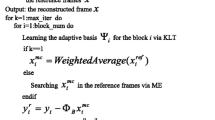Abstract
Fusion-based method for video enhancement has been playing a basic but significant role, which is also proved high-efficiency. Still, there are some open questions, such as lamp-off problem, over-enhanced moving objects and night shadow. To resolve the problems, a novel method—sparse codes fusion (SCF) is proposed. With plenty of samples from daytime videos and nighttime videos of the same scene, we learn and obtain a daytime dictionary and a nighttime dictionary using the proposed mutual coherence learning (MCL) algorithm. These two dictionaries are utilized for fusion and extracting context enhanced background. Moreover, we reconstruct the nighttime dictionary to get nighttime background that would be applied in motion extraction. Then the moving objects are added into the enhanced background. Extensive experimental results show a highly comprehensive description of video frames that leads to improvements over the state of the art on many usual public video datasets.












Similar content being viewed by others
References
Aharon M, Elad M, Bruckstein A (2006) K-SVD: an algorithm for designing overcomplete dictionaries for sparse representation. IEEE Trans Signal Process 55(11):4311–4322
Arici T, Dikbas S, Altunbasak Y (2009) A histogram modification framework and its application for image contrast enhancement. IEEE Trans Image Process 9(18):1921–1935
Bennett EP, McMillan L (2005) Video enhancement using per-pixel virtual exposures. Proc ACM Trans Graph 24(3):845–852
Cai YH et al (2006) Context enhancement of nighttime surveillance by image fusion. Proc. ICPR 2006, vol.1, pp 980–983
Cheng DY, Sun TF, Jiang XH (2013) A robust image classification scheme with sparse coding and multiple kernel learning. Digit Forensic Watermarking 7809:520–529
Durand F, Dorsey J (2002) Fast bilateral filtering for the display of high-dynamic range images. ACM Trans Graph 21(3):257–266
Harandi M (2012) Sparse coding and dictionary learning for symmetric positive definite matrices: a Kernel approach. European Conference on Computer Vision, pp 216–229
Ilie A, Raskar R, Yu JY (2005) Gradient domain context enhancement for fixed cameras. Int J Pattern Recognit Artif Intell 4(19):533–549
Ji Q, Yu S (2013) Motion object detection based on adaptive mixture Gaussian model and four-frame subtraction. International Conference on Computational and Information Sciences, pp 1202–1205
Lee C et al (2012) Power-constrained contrast enhancement for emissive displays based on histogram equalization. IEEE Trans Image Process 21(1):80–93
Lin W, Sun M-T, Poovendran R, Zhang Z (2010) Group event detection with a varying number of group members for video surveillance. IEEE Trans Circuits Syst Video Technol 8(20):1057–1067
Paris S, Halkias X, Glotin H (2012) Sparse coding for histograms of local binary patterns applied for image categorization: toward a bag-of-scenes analysis. International Conference on Pattern Recognition, pp 2817–2820
Rao YB, Chen LT (2012) A survey of video enhancement techniques. Int J Electr Eng Inform 3(1):71–99
Rao YB, Hou L, Wang ZH, Chen LT (2012) Illumination-based nighttime video contrast enhancement using genetic algorithm. Multimedia Tools Appl 70(3):2235–2254
Rao YB, Zhang YH, Gou JP (2013) Gradient fusion method for night video enhancement. ETRI J 35(5):923–926
Raskar R, Ilie A, Yu JY (2005) Image fusion for context enhancement and video surrealism. Proc. SIGGRAPH 2005. ACM, New York
Saponara S, Fanucci L, Petri E (2013) A multi-processor NoC-based architecture for real-time image/video enhancement. J Real-Time Image Proc 8(1):111–125
Tropp JA (2004) Greed is good: algorithmic results for sparse approximation. IEEE Trans Inf Theory 50(10):2231–2242
Tsai CY (2012) A fast dynamic range compression with local contrast preservation algorithm and its Application to real-time video enhancement. IEEE Trans Multimedia 14(4):1140–1152
Vollmer C, Gross HM, Eggert JP (2013) Learning features for activity recognition with shift-invariant sparse coding. Artif Neural Netw Mach Learn 8131:367–374
Wang Q, Ward RK (2007) Fast image/video contrast enhancement based on weighted threshold histogram equalization. IEEE Trans Consum Electron 53(2):757–764
Yamasaki A et al (2008) Denighting: enhancement of nighttime image for a surveillance camera. 19th Int. Conf. Pattern Recog
Zhu QD, Jing LQ, Bi RS (2010) Exploration and improvement of Ostu threshold segmentation algorithm. IEEE World Congress on Intelligent Control and Automation, pp 6183–6188
Acknowledgments
The authors would like to thank the anonymous reviewers for their helpful comments. This work is partly supported by National Science Foundation of China (Grant No. 61300092), Fundamental Research Funds for the Central Universities (Grant No. ZYGX2013J068), and Sichuan Province Science and Technology Support Program Project (Grant No. 2013GZ0151).
Author information
Authors and Affiliations
Corresponding author
Rights and permissions
About this article
Cite this article
Ding, X., Lei, H. & Rao, Y. Sparse codes fusion for context enhancement of night video surveillance. Multimed Tools Appl 75, 11221–11239 (2016). https://doi.org/10.1007/s11042-015-2844-6
Received:
Revised:
Accepted:
Published:
Issue Date:
DOI: https://doi.org/10.1007/s11042-015-2844-6




